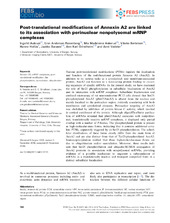| dc.contributor.author | Aukrust, Ingvild | en_US |
| dc.contributor.author | Rosenberg, Linn Andersen | en_US |
| dc.contributor.author | Ankerud, Mia Madeleine | en_US |
| dc.contributor.author | Bertelsen, Vibeke | en_US |
| dc.contributor.author | Hollås, Hanne | en_US |
| dc.contributor.author | Saraste, Jaakko | en_US |
| dc.contributor.author | Grindheim, Ann Kari | en_US |
| dc.contributor.author | Vedeler, Anni | en_US |
| dc.date.accessioned | 2017-11-03T13:38:34Z | |
| dc.date.available | 2017-11-03T13:38:34Z | |
| dc.date.issued | 2017-02 | |
| dc.Published | Aukrust I, Rosenberg, Ankerud, Bertelsen V, Hollås H, Saraste J, Grindheim AK, Vedeler A. Post-translational modifications of Annexin A2 are linked to its association with perinuclear nonpolysomal mRNP complexes. FEBS Open Bio. 2017;7(2):160-173 | eng |
| dc.identifier.issn | 2211-5463 | |
| dc.identifier.uri | https://hdl.handle.net/1956/16823 | |
| dc.description.abstract | Various post-translational modifications (PTMs) regulate the localisation and function of the multifunctional protein Annexin A2 (AnxA2). In addition to its various tasks as a cytoskeletal- and membrane-associated protein, AnxA2 can function as a trans-acting protein binding to cis-acting sequences of specific mRNAs. In the present study, we have examined the role of Ser25 phosphorylation in subcellular localisation of AnxA2 and its interaction with mRNP complexes. Subcellular fractionation and confocal microscopy of rat neuroendocrine PC12 cells showed that Ser25-phosphorylated AnxA2 (pSer25AnxA2) is absent from the nucleus and mainly localised to the perinuclear region, evidently associating with both membranes and cytoskeletal elements. Perinuclear targeting of AnxA2 was abolished by inhibition of protein kinase C activity, which resulted in cortical enrichment of the protein. Although oligo(dT)-affinity purification of mRNAs revealed that pSer25AnxA2 associates with nonpolysomal, translationally inactive mRNP complexes, it displayed only partial overlap with a marker of P-bodies. The phosphorylated protein is present as high-molecular-mass forms, indicating that it contains additional covalent PTMs, apparently triggered by its Ser25 phosphorylation. The subcellular distributions of these forms clearly differ from the main form of AnxA2 and are also distinct from that of Tyr23-phosphorylated AnxA2. Immunoprecipitation verified that these high-molecular-mass forms are due to ubiquitination and/or sumoylation. Moreover, these results indicate that Ser25 phosphorylation and ubiquitin/SUMO1 conjugation of AnxA2 promote its association with nonpolysomal mRNAs, providing evidence of a possible mechanism to sequester a subpopulation of mRNAs in a translationally inactive and transport competent form at a distinct subcellular localisation. | en_US |
| dc.language.iso | eng | eng |
| dc.publisher | Wiley | eng |
| dc.rights | Attribution CC BY | eng |
| dc.rights.uri | http://creativecommons.org/licenses/by/4.0/ | eng |
| dc.subject | Annexin A2 | eng |
| dc.subject | mRNP complexes | eng |
| dc.subject | posttranslational modification | eng |
| dc.subject | Ser phosphorylation | eng |
| dc.subject | sumoylation | eng |
| dc.subject | ubiquitination | eng |
| dc.title | Post-translational modifications of Annexin A2 are linked to its association with perinuclear nonpolysomal mRNP complexes | en_US |
| dc.type | Peer reviewed | |
| dc.type | Journal article | |
| dc.date.updated | 2017-10-10T07:20:14Z | |
| dc.description.version | publishedVersion | en_US |
| dc.rights.holder | Copyright 2017 The Author(s) | |
| dc.identifier.doi | https://doi.org/10.1002/2211-5463.12173 | |
| dc.identifier.cristin | 1424300 | |
| dc.source.journal | FEBS Open Bio | |

